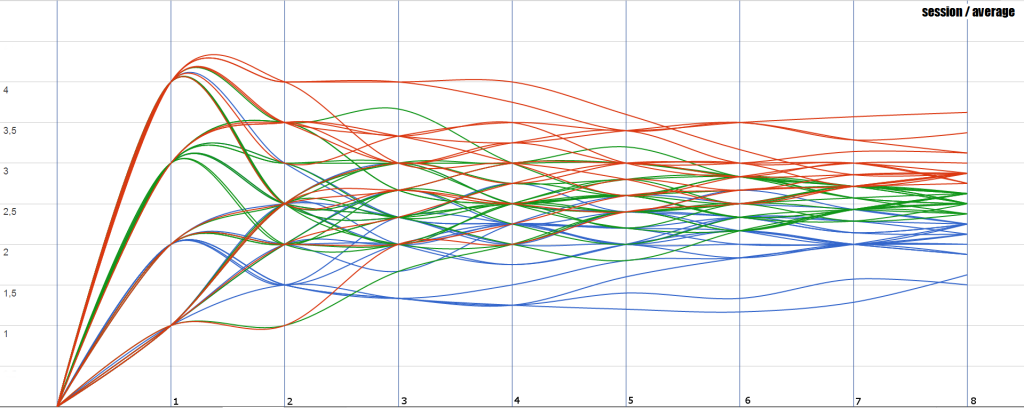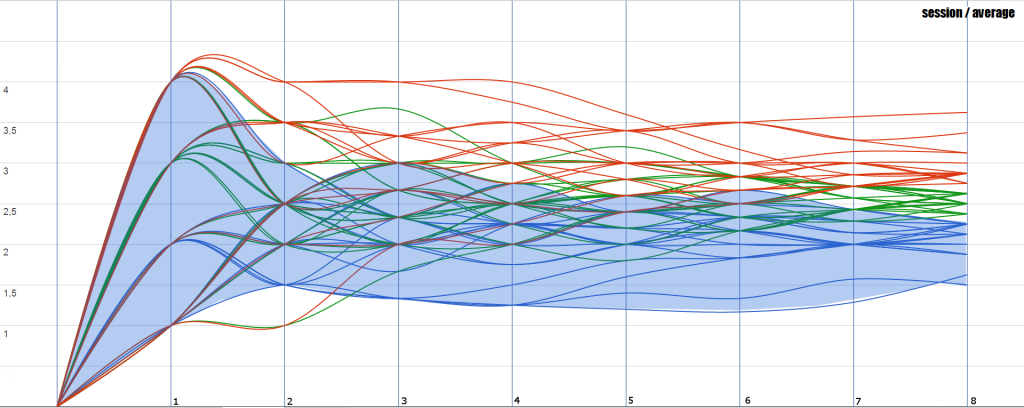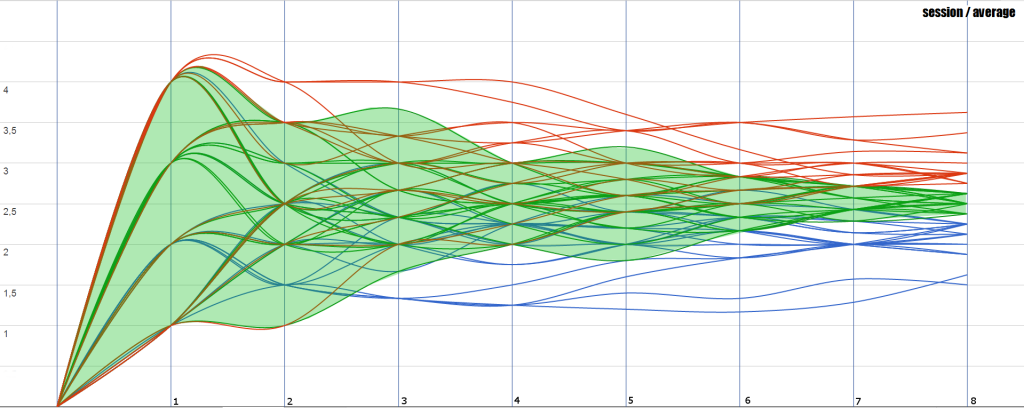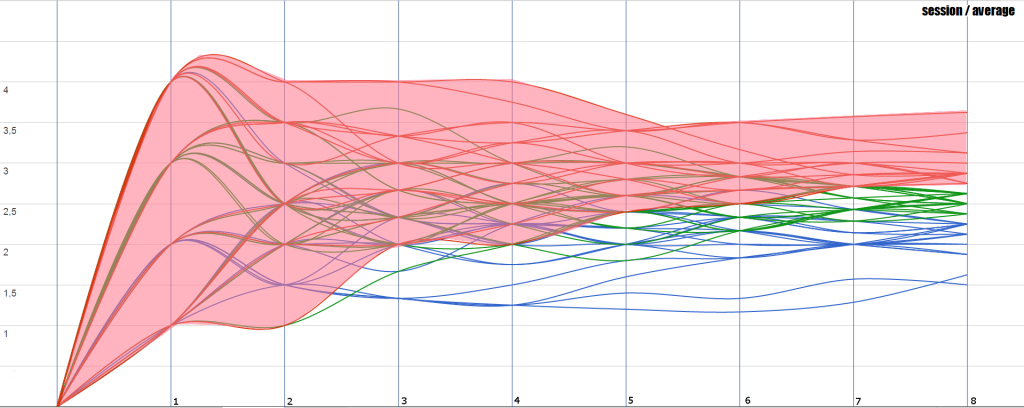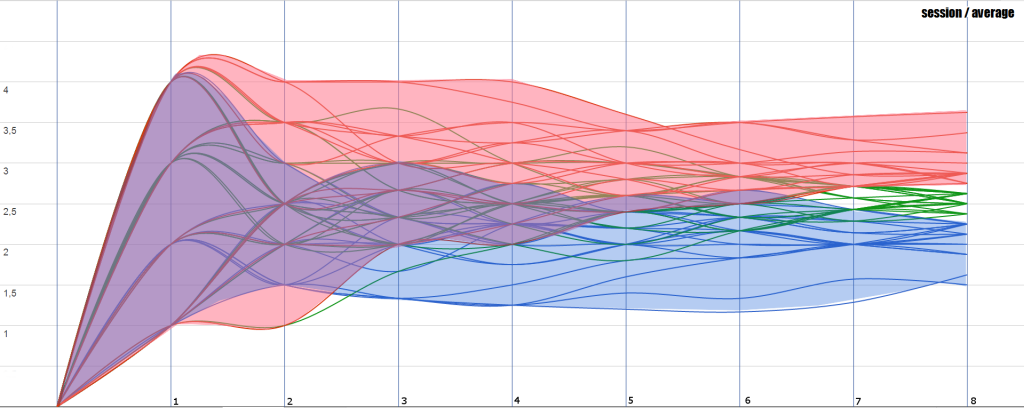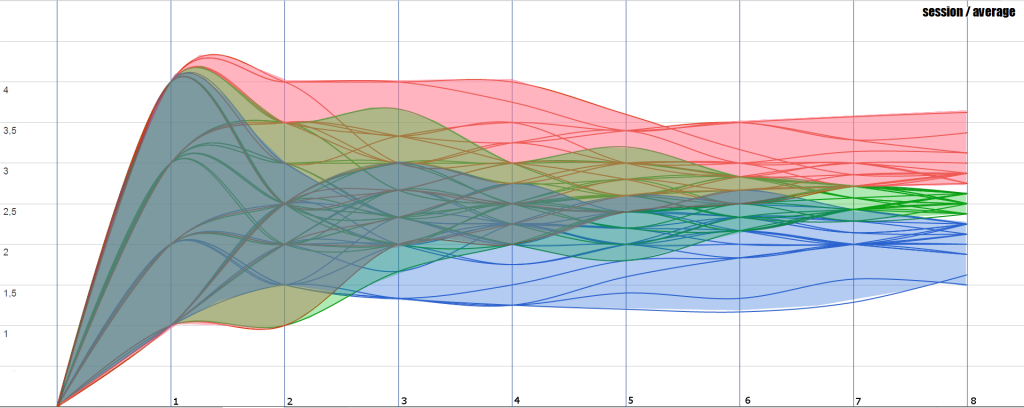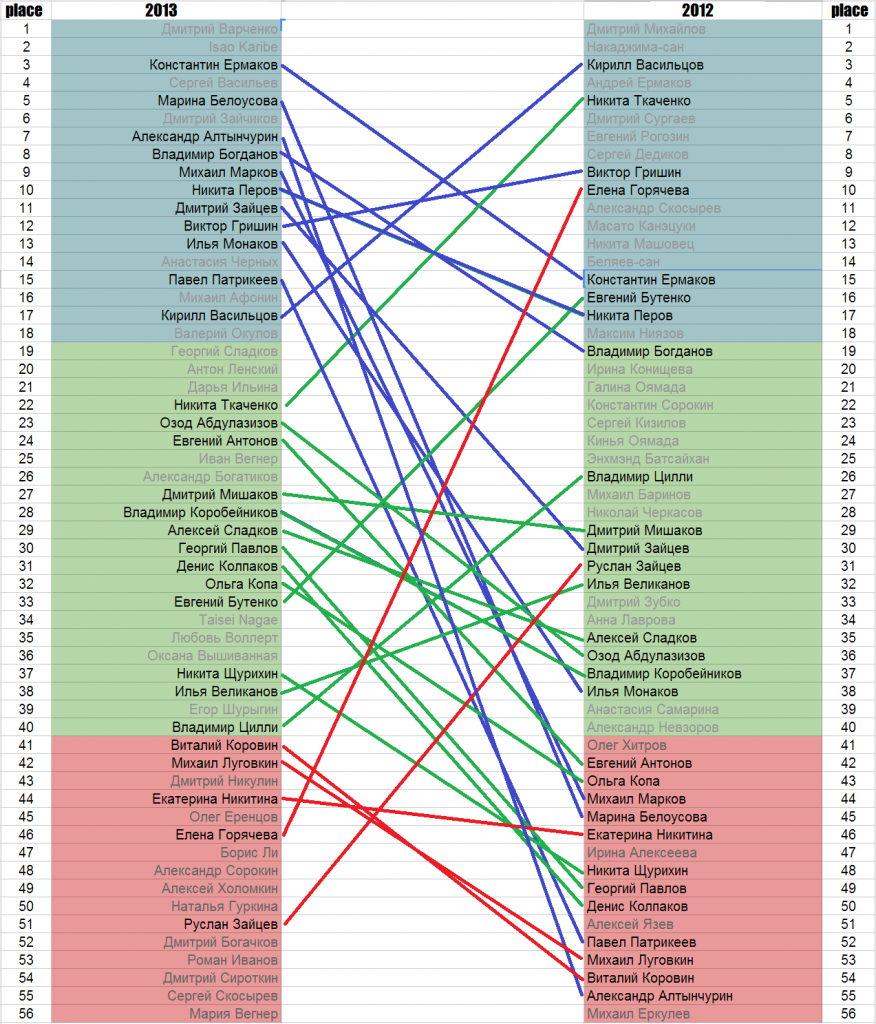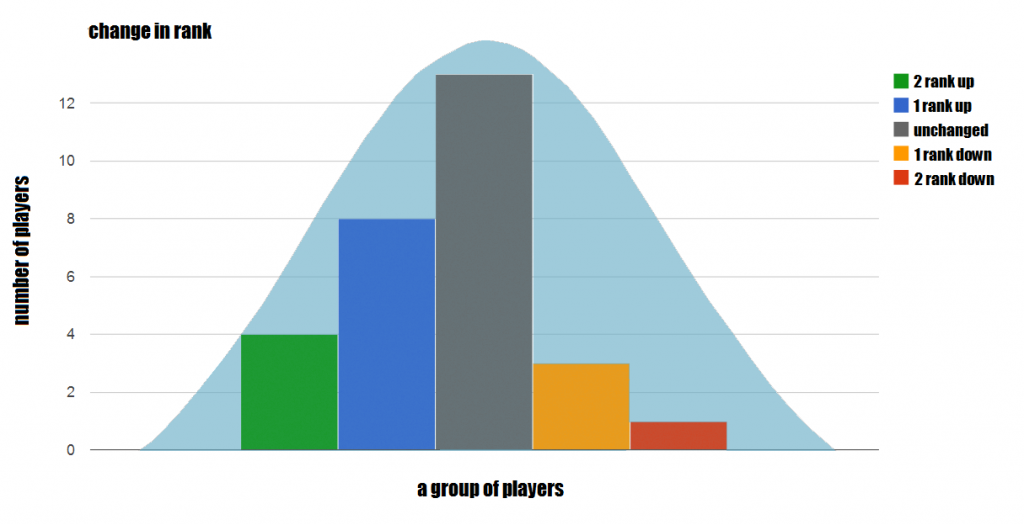Results Analysis
1. Choosing a seating system
There are two general schemes of seating which can be used in mahjong tournaments:
- Round-robin.
- Swiss system.
A round-robin tournament allows each contestant to meet all other contestants in turn. The ideal round-robin tournament demands a certain multiplicity of players’ and sessions’ number which is often not available in practice. An acceptable analogue of round-robin for mahjong tournaments is a scheme with the minimum number of repetitions. This scheme is quite difficult to program, it does not provide player’s ranking according to their skill during playing sessions, but this type of seating is a good one for small tournaments.
Swiss tournament has a simple system when the seating for the first session is random and in all other sessions players are seated according to the places they have had previously (with a certain gap). For example, with a gap of 4 the 1st player will be seated with the 5th, 9th and 13th, the 2nd player – with the 6th, 10th and 14th, the 17th player – with the 21st, 25th and 29th and so on. This scheme has a simple realisation, but it works well only if the number of players is large.
2. The seating system used on Japan House Reach Mahjong Cup.
During Japan House Reach Mahjong Cup we used the swiss system with a decreasing gap. The full list of sessions:
- 1st session. Random seating.
- 2nd session. Gap 7. Two groups of 7 * 4 = 28 players. Remainder: 4 players (the remainder was always seated randomly).
- 3rd session. Gap 6. Two groups of 6 * 4 = 24 players. Remainder: 12 players.
- 4th session. Gap 5. Three groups of 5 * 4 = 20 players. No remainder.
- 5th session. Gap 4. Three groups of 4 * 4 = 16 players. Remainder: 12 players.
- 6th session. Gap 4. Three groups of 4 * 4 = 16 players. Remainder: 12 players.
- 7th session. Gap 4. Three groups of 4 * 4 = 16 players. Remainder: 8 players (4 players, including 2 rep players, dropped out).
- 8th session. Gap 4. Three groups of 4 * 4 = 16 players. Remainder: 8 players.
3. Average place
Traditionally we use the average place as the main criterion and the sum of points as the secondary. Japanese mahjong requires much more skill to receive 1st and 2nd places without fails, then to gain a large number of points once or twice by chance.
Here is the graph which shows the changing of the average places of all 56 players:
For convenience’ sake we divided all players into three ranks: А (blue – 18 players):
B (green – 20 players):
C (red – 18 players):
Let’s take a look on the intersection of ranks A and C:
We can see the ordered motion of average places of leaders’ group and outsiders’ group. This divergence is getting clearer within the first day and reaches its limit in two last sessions of the second day, when intersections between ranks A and С become impossible.
Let’s add the B rank:
We can conclude that adding of a small number of sessions will not affect the results in general, because the average place changes gradually. To correct the results significantly, we have to add a half of the distance traveled (4 sessions), but this correction will work only for the minority of players, because after 8 sessions the players are already ranked quite clearly according to their skill.
A key advantage of using the average place as the main criterion is that abrupt and unpredictable movements between places in the end of the tournament become impossible, while ranking according to the sum of points allows to weak players to rise high after gaining a sudden yakuman.
4. Representativeness of the results
In 2012 the Moscow Open Riichi Tournament, which can be used for comparison, took place. Its relsults also had the average place as the main criterion and the tournament scheme provided the seating according to players’ skill. There were 56 players, as much as in 2013, but the number of sessions was half as much – 4 playing sessions.
Let’s compare the standings of players and count the number of players who changed their ranks:
29 players took part in both tournaments. Of them:
- improved their rank and moved from C to A – 4 players,
- improved their rank and moved from B to A – 3 players,
- improved their rank and moved from C to B – 5 players,
- kept rank A – 4 players,
- kept rank B – 6 players,
- kept rank C – 3 players,
- worsened their rank and moved from B to C – 1 player,
- worsened their rank and moved from A to B – 2 players,
- worsened their rank and moved from A to C – 1 player.
We can generalize this data:
The graph shows the normal distribution of probability of change in ranks. The right part of the graph is clearly lower than the left. This can be explained by the progress in skill of the players in a year, since a simple dispersion would make both parts of the graph equal. The normal distribution of change in ranks does not only show the representativeness of the results, it can also be used for prediction of the same players’ standings in next tournaments with the swiss system and the average place as the first criterion.
5. Repetitions between players
8 playing sessions allow to each contestant to play with 24 unique opponents maximally (it’s less than half of all players who took part in Japan House Reach Mahjong Cup). However, the swiss system results in more repetitions. Here is a number of meetings for each player (opponents, who met only once, are not shown):
- Dmitriy Varchenko: Aleksandr Bogatikov 2, Nikita Perov 2
- Isao Karibe: Evgeniy Butenko 2, Dmitriy Zaychikov 2, Konstantin Ermakov 2, Mikhail Afonin 2
- Konstantin Ermakov: Dmitriy Zaytsev 2, Ivan Vegner 2, Aleksandr Altynchurin 2, Vladimir Bogdanov 3, Isao Karibe 2
- Sergey Vasilev: Kirill Vasiltsov 2, Viktor Grishin 3, Anton Lenskiy 3, Nikita Perov 3
- Marina Belousova: Ilya Monakov 2, Dmitriy Zaychikov 2, Nikita Tkachenko 2
- Dmitriy Zaychikov: Marina Belousova 2, Evgeniy Butenko 2, Pavel Patrikeev 2, Isao Karibe 2
- Aleksandr Altynchurin: Natalya Gurkina 2, Evgeniy Antonov 2, Egor Shurygin 2, Aleksey Kholomkin 2, Konstantin Ermakov 2, Vladimir Bogdanov 2
- Vladimir Bogdanov: Aleksandr Altynchurin 2, Egor Shurygin 2, Ruslan Zaytsev 2, Viktor Grishin 3, Konstantin Ermakov 3
- Mikhail Markov: Natalya Gurkina 2, Pavel Patrikeev 4, Nikita Perov 2
- Nikita Perov: Aleksandr Bogatikov 2, Dmitriy Varchenko 2, Sergey Vasilev 3, Mikhail Markov 2
- Dmitriy Zaytsev: Anastasiya Chernykh 2, Konstantin Ermakov 2, Taisei Nagae 2
- Viktor Grishin: Egor Shurygin 3, Vladimir Bogdanov 3, Sergey Vasilev 3
- Ilya Monakov: Aleksandr Bogatikov 2, Marina Belousova 2, Nikita Shchurikhin 2
- Anastasiya Chernykh: Dmitriy Zaytsev 2, Taisei Nagae 2, Lyubov Vollert 2
- Pavel Patrikeev: Aleksandr Bogatikov 2, Dmitriy Zaychikov 2, Nikita Tkachenko 2, Mikhail Markov 4
- Mikhail Afonin: Isao Karibe 2
- Kirill Vasiltsov: Sergey Vasilev 2, Anton Lenskiy 2, Nikita Shchurikhin 2
- Valeriy Okulov: Natalya Gurkina 2, Lyubov Vollert 3
- Georgiy Sladkov: Vladimir Tsilli 2, Nikita Shchurikhin 2, Anton Lenskiy 2, Lyubov Vollert 2
- Anton Lenskiy: Kirill Vasiltsov 2, Georgiy Sladkov 2, Sergey Vasilev 3
- Darya Ilina: Evgeniy Butenko 4, Ozod Abdulazizov 2
- Nikita Tkachenko: Marina Belousova 2, Ozod Abdulazizov 2, Pavel Patrikeev 2, Aleksandr Sorokin 2
- Ozod Abdulazizov: Darya Ilina 2, Evgeniy Butenko 2, Olga Kopa 2, Nikita Tkachenko 2
- Evgeniy Antonov: Dmitriy Sirotkin 2, Aleksandr Altynchurin 2, Dmitriy Bogachkov 2, Mariya Vegner 2, Lyubov Vollert 2, Taisei Nagae 2
- Ivan Vegner: Vladimir Korobeynikov 2, Konstantin Ermakov 2
- Aleksandr Bogatikov: Ilya Monakov 2, Dmitriy Varchenko 2, Pavel Patrikeev 2, Nikita Perov 2
- Dmitriy Mishakov: Natalya Gurkina 3, Vladimir Korobeynikov 2, Mikhail Lugovkin 4
- Vladimir Korobeynikov: Ivan Vegner 2, Mikhail Lugovkin 2, Oksana Vyshivannaya 2, Dmitriy Mishakov 2
- Aleksey Sladkov: Boris Li 2, Oleg Erentsov 2, Ruslan Zaytsev 2, Roman Ivanov 3
- Georgiy Pavlov: Ilya Velikanov 3, Elena Goryacheva 3, Aleksandr Sorokin 2
- Denis Kolpakov: Dmitriy Nikulin 3, Ekaterina Nikitina 2, Vitaliy Korovin 2, Oksana Vyshivannaya 2
- Olga Kopa: Dmitriy Bogachkov 2, Ozod Abdulazizov 2
- Evgeniy Butenko: Darya Ilina 4, Dmitriy Zaychikov 2, Ozod Abdulazizov 2, Isao Karibe 2
- Taisei Nagae: Dmitriy Zaytsev 2, Evgeniy Antonov 2, Anastasiya Chernykh 2
- Lyubov Vollert: Natalya Gurkina 2, Evgeniy Antonov 2, Dmitriy Sirotkin 2, Anastasiya Chernykh 2, Georgiy Sladkov 2, Valeriy Okulov 3
- Oksana Vyshivannaya: Vladimir Korobeynikov 2, Ruslan Zaytsev 2, Denis Kolpakov 2, Dmitriy Bogachkov 2, Aleksandr Sorokin 2
- Nikita Shchurikhin: Ilya Monakov 2, Kirill Vasiltsov 2, Georgiy Sladkov 2
- Ilya Velikanov: Georgiy Pavlov 3
- Egor Shurygin: Aleksandr Altynchurin 2, Viktor Grishin 3, Vladimir Bogdanov 2, Sergey Skosyrev 2, Aleksandr Sorokin 2
- Vladimir Tsilli: Georgiy Sladkov 2
- Vitaliy Korovin: Dmitriy Nikulin 2, Denis Kolpakov 2, Mariya Vegner 2, Elena Goryacheva 2, Roman Ivanov 2
- Mikhail Lugovkin: Natalya Gurkina 2, Vladimir Korobeynikov 2, Dmitriy Mishakov 4
- Dmitriy Nikulin: Boris Li 3, Denis Kolpakov 3, Vitaliy Korovin 2, Mariya Vegner 2, Elena Goryacheva 2
- Ekaterina Nikitina: Dmitriy Sirotkin 4, Denis Kolpakov 2, Aleksey Kholomkin 2
- Oleg Erentsov: Boris Li 2, Aleksey Sladkov 2
- Elena Goryacheva: Dmitriy Nikulin 2, Vitaliy Korovin 2, Georgiy Pavlov 3
- Boris Li: Oleg Erentsov 2, Dmitriy Nikulin 3, Aleksey Sladkov 2
- Aleksandr Sorokin: Egor Shurygin 2, Ruslan Zaytsev 4, Nikita Tkachenko 2, Oksana Vyshivannaya 2, Georgiy Pavlov 2
- Aleksey Kholomkin: Dmitriy Sirotkin 2, Aleksandr Altynchurin 2, Ekaterina Nikitina 2, Mariya Vegner 3
- Natalya Gurkina: Mikhail Lugovkin 2, Aleksandr Altynchurin 2, Valeriy Okulov 2, Mikhail Markov 2, Lyubov Vollert 2, Dmitriy Mishakov 3
- Ruslan Zaytsev: Aleksey Sladkov 2, Vladimir Bogdanov 2, Oksana Vyshivannaya 2, Aleksandr Sorokin 4
- Dmitriy Bogachkov: Evgeniy Antonov 2, Olga Kopa 2, Oksana Vyshivannaya 2, Sergey Skosyrev 2, Roman Ivanov 2
- Roman Ivanov: Aleksey Sladkov 3, Vitaliy Korovin 2, Dmitriy Bogachkov 2, Mariya Vegner 2, Sergey Skosyrev 4
- Dmitriy Sirotkin: Evgeniy Antonov 2, Ekaterina Nikitina 4, Aleksey Kholomkin 2, Sergey Skosyrev 2, Lyubov Vollert 2
- Sergey Skosyrev: Dmitriy Sirotkin 2, Egor Shurygin 2, Dmitriy Bogachkov 2, Roman Ivanov 4
- Mariya Vegner: Evgeniy Antonov 2, Dmitriy Nikulin 2, Aleksey Kholomkin 3, Vitaliy Korovin 2, Roman Ivanov 2
In total we see 129 repeated meetings in (56 / 4) * 8 = 112 hanchans in a tournament with 56 players. The best result – 2 repeated meetings, the worst – 8 repeated meetings (from 24 meetings in total). The average result – 4,6 repeated meetings. It is 10-15% more than a total random seating in all 8 sessions would provide (according to the computer modeling). The swiss system makes repeated meetings inevitable and this is not an accident, but rather a result of strong players meeting with strong opponents and weak meeting the weak. In this seating system two certain strong (or weak) players may not meet at all – their skill would be compared indirectly in games with the same opponents.
